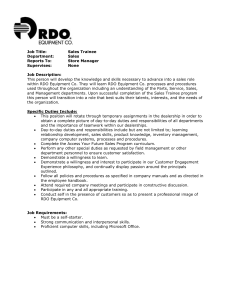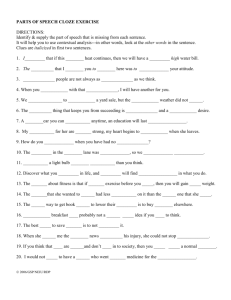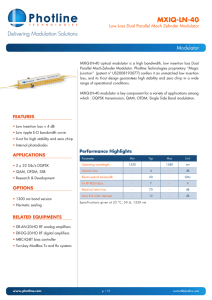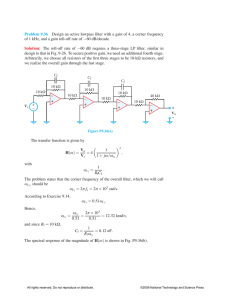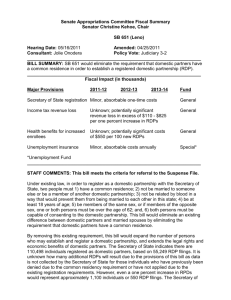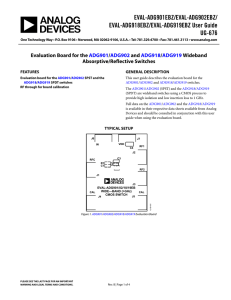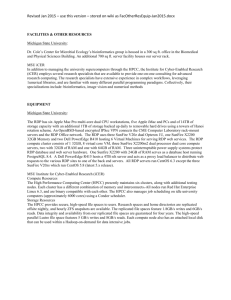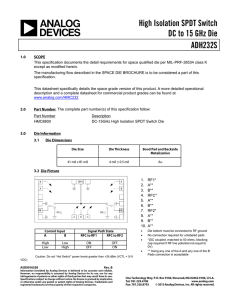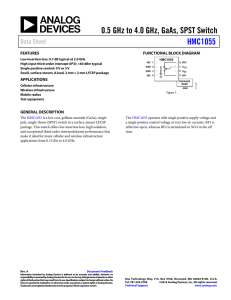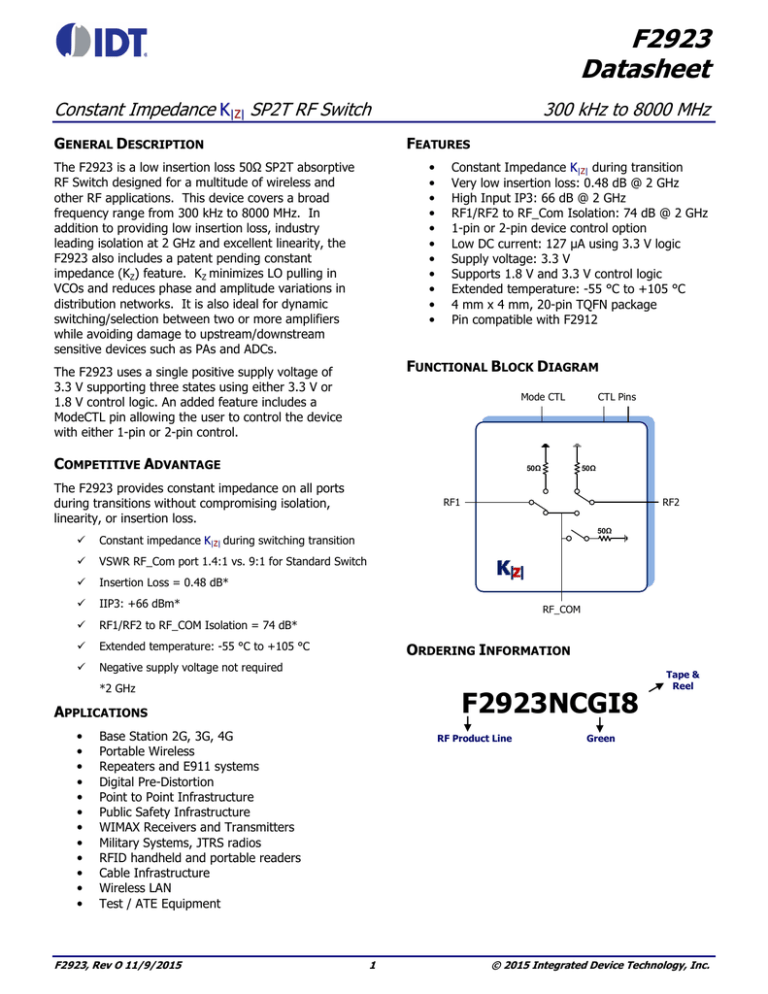
F2923
Datasheet
Constant Impedance K|Z| SP2T RF Switch
GENERAL DESCRIPTION
300 kHz to 8000 MHz
FEATURES
The F2923 is a low insertion loss 50Ω SP2T absorptive
RF Switch designed for a multitude of wireless and
other RF applications. This device covers a broad
frequency range from 300 kHz to 8000 MHz. In
addition to providing low insertion loss, industry
leading isolation at 2 GHz and excellent linearity, the
F2923 also includes a patent pending constant
impedance (KZ) feature. KZ minimizes LO pulling in
VCOs and reduces phase and amplitude variations in
distribution networks. It is also ideal for dynamic
switching/selection between two or more amplifiers
while avoiding damage to upstream/downstream
sensitive devices such as PAs and ADCs.
•
•
•
•
•
•
•
•
•
•
•
Constant Impedance K|Z| during transition
Very low insertion loss: 0.48 dB @ 2 GHz
High Input IP3: 66 dB @ 2 GHz
RF1/RF2 to RF_Com Isolation: 74 dB @ 2 GHz
1-pin or 2-pin device control option
Low DC current: 127 µA using 3.3 V logic
Supply voltage: 3.3 V
Supports 1.8 V and 3.3 V control logic
Extended temperature: -55 °C to +105 °C
4 mm x 4 mm, 20-pin TQFN package
Pin compatible with F2912
FUNCTIONAL BLOCK DIAGRAM
The F2923 uses a single positive supply voltage of
3.3 V supporting three states using either 3.3 V or
1.8 V control logic. An added feature includes a
ModeCTL pin allowing the user to control the device
with either 1-pin or 2-pin control.
Mode CTL
COMPETITIVE ADVANTAGE
50Ω
The F2923 provides constant impedance on all ports
during transitions without compromising isolation,
linearity, or insertion loss.
CTL Pins
50Ω
RF1
RF2
50Ω
Constant impedance K|Z| during switching transition
VSWR RF_Com port 1.4:1 vs. 9:1 for Standard Switch
Insertion Loss = 0.48 dB*
IIP3: +66 dBm*
RF1/RF2 to RF_COM Isolation = 74 dB*
Extended temperature: -55 °C to +105 °C
Negative supply voltage not required
RF_COM
ORDERING INFORMATION
Tape &
Reel
*2 GHz
F2923NCGI8
APPLICATIONS
•
•
•
•
•
•
•
•
•
•
•
•
Base Station 2G, 3G, 4G
Portable Wireless
Repeaters and E911 systems
Digital Pre-Distortion
Point to Point Infrastructure
Public Safety Infrastructure
WIMAX Receivers and Transmitters
Military Systems, JTRS radios
RFID handheld and portable readers
Cable Infrastructure
Wireless LAN
Test / ATE Equipment
F2923, Rev O 11/9/2015
RF Product Line
1
Green
© 2015 Integrated Device Technology, Inc.
F2923
ABSOLUTE MAXIMUM RATINGS
Parameter / Condition
Vcc to GND
CTL1, CTL2
ModeCTL to GND
RF1, RF2, RF_COM
Maximum Junction Temperature
Storage Temperature Range
Lead Temperature (soldering, 10s)
ESD Voltage– HBM (Per JESD22-A114)
ESD Voltage – CDM (Per JESD22-C101)
Symbol
Vcc
VCNTL
VMODE
VRF
TJmax
TST
TLEAD
VESDHBM
VESDCDM
Min
-0.3
-0.3
-0.3
-0.3
-65
Max
+3.9
Vcc + 0.3
Vcc + 0.3
+0.3
+140
+150
+260
Class 2
Class III
ABS MAX RF POWER AT 2 GHZ WITH TC = +85 °C *
RF1, RF2, RF_COM (RF1 or RF2 is connected to RF_COM, IL States)
RF1, RF2, RF_COM (When port is internally terminated)
+33dBm
+24dBm
ABS MAX RF POWER AT 2 GHZ WITH TC = +105 °C *
RF1, RF2, RF_COM (RF1 or RF2 is connected to RF_COM, IL States)
RF1, RF2, RF_COM (When port is internally terminated)
+33dBm
+21dBm
Unit
V
V
V
V
°C
°C
°C
* Temperature of exposed paddle
Stresses above those listed above may cause permanent damage to the device. Functional operation of the device at
these or any other conditions above those indicated in the operational section of this specification is not implied.
Exposure to absolute maximum rating conditions for extended periods may affect device reliability.
PACKAGE THERMAL AND MOISTURE CHARACTERISTICS
θJA (Junction – Ambient)
θJC (Junction – Case) The Case is defined as the exposed paddle
Moisture Sensitivity Rating (Per J-STD-020)
Constant Impedance Absorptive SP2T RF Switch
2
60 °C/W
3.9 °C/W
MSL1
Rev O 11/9/2015
F2923
F2923 RECOMMENDED OPERATING CONDITIONS
Parameter
Supply Voltage
Operating Temperature
Range
RF Frequency Range
Symbol
VCC
TCASE
Conditions
Case Temperature
FRF
Min
3.1
Typ
-55
+105
0.3
8000
27
Selected Port (I.L. State)
RF Continuous
Input Power (CW) 1
PRF
RF1 Port Impedance
ZRF1
50
RF2 Port Impedance
ZRF2
50
ZRF_COM
50
RF_COM Port Impedance
Max
3.5
Unselected Port2 (Term State)
18
Units
V
O
C
MHz
dBm
Ω
Note 1– See Figure 1 below for RF power handling levels for various conditions.
Note 2– States 1, 2, or 3.
FIGURE 1: MAXIMUM OPERATING RF INPUT POWER VS. RF FREQUENCY
Rev O 11/9/2015
3
Constant Impedance Absorptive SP2T RF Switch
F2923
F2923 SPECIFICATION
Typical Application Circuit, VCC = +3.3 V, TC = +25 °C, FRF = 2 GHz, input power = 0 dBm unless otherwise stated.
PCB board trace and connector losses are de-embedded unless otherwise noted.
Min
Typ
Max
Units
Parameter
Symbol
Conditions
Logic Input High
VIH
CTL1 and CTL2 pins
1.1
3.6
V
Threshold
Logic Input Low
VIL
CTL1 and CTL2 pins
0.6
V
Threshold
ModeCTL Input High
Vcc
V
ModeCTL Input Low
GND
V
Logic Current
IIH, IIL
CTL1, CTL2, ModeCTL pins
1000
nA
DC Current (Vcc)
ICC
State 2 or State 3
127
150
µA
VSWR during transition
VSWRT
RF1/RF2 to RF_COM
1.4:1
RF = 1 GHz
0.43
RF = 2 GHz
0.48
0.8 1
Insertion Loss
RF1/RF2 to RF_COM
IL
RF = 4 GHz
0.63
dB
(State 2 or 3)
RF = 6 GHz
0.89
RF = 8 GHz
1.12
RF = 1 GHz
77
RF = 2 GHz
712
74
Isolation
RF1 / RF2 to RF_COM
ISO1
RF = 4 GHz
51
dB
(State 2 or 3)
RF = 6 GHz
40
RF = 8 GHz
37
RF = 1 GHz
73
RF = 2 GHz
61
63
Isolation
RF1 to RF2
ISO2
dB
RF = 4 GHz
51
(State 2 or 3)
RF = 6 GHz
35
RF = 8 GHz
29
RF = 1 GHz
23.8
RF = 2 GHz
25.2
Return Loss RF_COM
RL1
RF = 4 GHz
26.7
dB
(State 1)
RF = 6 GHz
18.4
RF = 8 GHz
16.6
RF = 1 GHz
29.6
RF = 2 GHz
25.4
Return Loss RF_COM
RF = 4 GHz
26.1
RL2
dB
(State 2 or 3)
RF = 6 GHz
17.6
RF = 8 GHz
14.1
Note 1– Items in min/max columns in bold italics are Guaranteed by Test.
Note 2– Items in min/max columns NOT in bold italics are Guaranteed by Design Characterization.
Constant Impedance Absorptive SP2T RF Switch
4
Rev O 11/9/2015
F2923
F2923 SPECIFICATION (CONT.)
Typical Application Circuit, VCC = +3.3 V, TC = +25 °C, FRF = 2 GHz, input power = 0 dBm unless otherwise stated.
PCB board trace and connector losses are de-embedded unless otherwise noted.
Parameter
Symbol
Conditions
Min
Typ
Max
Units
RF = 1 GHz
22.6
RF = 2 GHz
23.4
Return Loss
RF1, RF2
RL3
RF = 4 GHz
25.2
dB
(State 1)
RF = 6 GHz
19.9
RF = 8 GHz
11.2
RF = 1 GHz
33.7
RF = 2 GHz
28.4
Return Loss
RF1, RF2 when selected
RL4
RF = 4 GHz
28.0
dB
(State 2 or 3)
RF = 6 GHz
17.7
RF = 8 GHz
15.0
RF
=
1
GHz
116
Input IP2
PIN= +13 dBm
RF = 2 GHz
106
dBm
RF1 / RF2
IIP2
per tone
(State 2 or 3)
RF = 3 GHz
105
RF = 1 GHz
66
RF = 2 GHz
66
Input IP3
PIN =+13 dBm
RF1 / RF2
IIP3
RF = 3 GHz
65
dBm
per tone
(State 2 or 3)
RF = 4 GHz
65
RF = 6 GHz
52
Input 1dB compression
IP1dB
RF = 2 GHz
32
dBm
RF1 / RF2 (State 2 or 3) 3
50% control to 90% RF
0.6
50% control to 10% RF
0.5
Switching Time4
TSW
µs
50% control to RF settled to
0.675
within +/- 0.1 dB of I.L.
value.
Maximum Switching Rate
SWRATE
25
kHz
Maximum spurious level
SpurMAX
RF ports terminated into 50Ω
-137
dBm
on any RF port5
Note 1– Items in min/max columns in bold italics are Guaranteed by Test.
Note 2– Items in min/max columns NOT in bold italics are Guaranteed by Design Characterization.
Note 3– The input 1dB compression point is a linearity figure of merit. Refer to Figure 1 above and
Recommended Operating Conditions sections for the maximum RF input powers.
Note 4– FRF = 2 GHz.
Note 5– Spurious due to on-chip negative voltage generator. Typical generator fundamental frequency is 2.2 MHz.
Rev O 11/9/2015
5
Constant Impedance Absorptive SP2T RF Switch
F2923
Table 1 includes 3 states and provides the truth table for 2-pin control input.
Table 1 - Switch Control Truth Table for 3 states using 2 control pins; pin 16 and pin 17
Control pin input
State
1
2
3
4
CTL1
(Pin 17)
Low
Low
High
High
CTL2
(Pin 16)
Low
High
Low
High
RF1, RF2 input / output
RF1 to RF Com
RF2 to RF Com
OFF
OFF
ON
N/A
OFF
ON
OFF
N/A
Table 2 includes 2 states and provides the truth table for 1-pin control input.
Table 2 - Switch Control Truth Table for 2 states using a single control pin 16
Control pin input
State
2
3
CTL1
(Pin 17)
don't care
don't care
CTL2
(Pin 16)
High
Low
RF1, RF2 input / output
RF1 to RF Com
RF2 to RF Com
OFF
ON
ON
OFF
Table 3 provides the truth table for selecting the use of either 1 or 2 control pins.
Table 3 - Mode Control (pin 19) Truth table to use either 1 or 2 control pins
Pin Control Mode
ModeCTL (Pin 19)
2-pin control: CTL1 and CTL2
GND
1-pin control: CTL2
VCC
Notes:
1. When RF1 and RF2 ports are both open (State 1), all 3 RF ports are terminated to an internal 50 Ω termination
resistor.
2. When RF1 or RF2 port is open (State 2 or State 3 OFF condition), the open port is connected to an internal
50Ω termination resistor.
3. When RF1 or RF2 port is closed (State 2 or State 3 ON condition), the closed port is connected to the
RF_COM port.
TYPICAL OPERATING CURVE CONDITIONS
Unless otherwise noted, the following conditions apply:
•
•
•
•
•
•
EVKit loss de-embedded for only insertion loss plots.
Vcc = 3.3 V
FRF = 2 GHz
TAMB = 25 OC
Small signal parameters measured with PIN = 0dBm.
Two tone tests PIN =+13 dBm/tone with 50 MHz tone spacing.
Constant Impedance Absorptive SP2T RF Switch
6
Rev O 11/9/2015
F2923
TYPICAL OPERATING CONDITIONS (- 1 -)
Insertion Loss vs. Temperature
Insertion Loss vs. Voltage
0
Insertion Loss (dB)
Insertion Loss (dB)
0
-0.4
-0.8
-1.2
RF1 Sel, -55C
RF1 Sel, 25C
RF1 Sel, 105C
-1.6
RF2 Sel, -55C
RF2 Sel, 25C
RF2 Sel, 105C
-2
-0.4
-0.8
-1.2
RF1 Sel, 3.1V
RF1 Sel, 3.3V
RF1 Sel, 3.5V
-1.6
-2
0
1
2
3
4
5
6
7
8
0
1
2
Frequency (GHz)
4
5
6
7
8
Isolation vs. Voltage [RF_COM RF1 / RF2]
0
0
RF1 Sel, -55C
RF1 Sel, 25C
RF1 Sel, 105C
-10
RF2 Sel, -55C
RF2 Sel, 25C
RF2 Sel, 105C
RF1 Sel, 3.1V
RF1 Sel, 3.3V
RF1 Sel, 3.5V
-10
-20
Isolation (dB)
-20
Isolation (dB)
3
Frequency (GHz)
Isolation vs. Temp [RF_COM RF1 / RF2]
-30
-40
-50
-60
-70
-80
RF2 Sel, 3.1V
RF2 Sel, 3.3V
RF2 Sel, 3.5V
-30
-40
-50
-60
-70
-80
-90
-90
-100
-100
0
1
2
3
4
5
6
7
8
0
1
2
Frequency (GHz)
3
4
5
6
7
8
Frequency (GHz)
Isolation vs. Temp [RF1 RF2, RF2 RF1]
Isolation vs. Voltage [RF1 RF2, RF2 RF1]
0
0
RF1 Sel, -55C
RF1 Sel, 25C
RF1 Sel, 105C
-10
RF2 Sel, -55C
RF2 Sel, 25C
RF2 Sel, 105C
RF1 Sel, 3.1V
RF1 Sel, 3.3V
RF1 Sel, 3.5V
-10
-20
Isolation (dB)
-20
Isolation (dB)
RF2 Sel, 3.1V
RF2 Sel, 3.3V
RF2 Sel, 3.5V
-30
-40
-50
-60
-70
-80
RF2 Sel, 3.1V
RF2 Sel, 3.3V
RF2 Sel, 3.5V
-30
-40
-50
-60
-70
-80
-90
-90
-100
-100
0
1
2
3
4
5
6
7
8
0
Frequency (GHz)
Rev O 11/9/2015
1
2
3
4
5
6
7
8
Frequency (GHz)
7
Constant Impedance Absorptive SP2T RF Switch
F2923
TYPICAL OPERATING CONDITIONS (- 2 -)
RF1 Return Loss vs. Voltage
RF1 Return Loss vs. Temperature
0
0
Return Loss (dB)
-5
-10
RF2 Sel, -55C
RF2 Sel, 25C
RF2 Sel, 105C
RF1 Sel, 3.1V
RF1 Sel, 3.3V
RF1 Sel, 3.5V
-5
Return Loss (dB)
RF1 Sel, -55C
RF1 Sel, 25C
RF1 Sel, 105C
-15
-20
-25
-30
-35
-10
-15
-20
-25
-30
-35
-40
-40
0
1
2
3
4
5
6
7
8
0
1
2
Frequency (GHz)
4
5
6
7
8
7
8
7
8
RF2 Return Loss vs. Voltage
0
0
-10
RF2 Sel, -55C
RF2 Sel, 25C
RF2 Sel, 105C
RF1 Sel, 3.1V
RF1 Sel, 3.3V
RF1 Sel, 3.5V
-5
Return Loss (dB)
RF1 Sel, -55C
RF1 Sel, 25C
RF1 Sel, 105C
-5
Return Loss (dB)
3
Frequency (GHz)
RF2 Return Loss vs. Temperature
-15
-20
-25
-30
-35
-10
RF2 Sel, 3.1V
RF2 Sel, 3.3V
RF2 Sel, 3.5V
-15
-20
-25
-30
-35
-40
-40
0
1
2
3
4
5
6
7
8
0
1
2
Frequency (GHz)
3
4
5
6
Frequency (GHz)
RF_COM Return Loss vs. Temperature
RF_COM Return Loss vs. Voltage
0
0
-10
RF2 Sel, -55C
RF2 Sel, 25C
RF2 Sel, 105C
RF1 Sel, 3.1V
RF1 Sel, 3.3V
RF1 Sel, 3.5V
-5
Return Loss (dB)
RF1 Sel, -55C
RF1 Sel, 25C
RF1 Sel, 105C
-5
Return Loss (dB)
RF2 Sel, 3.1V
RF2 Sel, 3.3V
RF2 Sel, 3.5V
-15
-20
-25
-30
-35
-10
RF2 Sel, 3.1V
RF2 Sel, 3.3V
RF2 Sel, 3.5V
-15
-20
-25
-30
-35
-40
-40
0
1
2
3
4
5
6
7
8
0
Frequency (GHz)
Constant Impedance Absorptive SP2T RF Switch
1
2
3
4
5
6
Frequency (GHz)
8
Rev O 11/9/2015
F2923
TYPICAL OPERATING CONDITIONS (- 3 -)
Isolation vs. Temp [All Off State, RF_COM Driven]
Isolation vs. Voltage [All Off State, RF_COM Driven]
0
0
RF1 Out, -55C
RF1 Out, 25C
RF1 Out, 105C
-10
RF1 Out, 3.1V
RF1 Out, 3.3V
RF1 Out, 3.5V
-10
-20
Isolation (dB)
Isolation (dB)
-20
RF2 Out, -55C
RF2 Out, 25C
RF2 Out, 105C
-30
-40
-50
-60
-70
-80
-30
-40
-50
-60
-70
-80
-90
-90
-100
-100
0
1
2
3
4
5
6
7
8
0
1
2
Frequency (GHz)
4
5
6
7
8
RF_COM Return Loss [All Off State] vs. Voltage
0
0
-55C
25C
105C
-10
3.1V
3.3V
3.5V
-5
Return Loss (dB)
-5
Return Loss (dB)
3
Frequency (GHz)
RF_COM Return Loss [All Off State] vs. Temp
-15
-20
-25
-30
-35
-10
-15
-20
-25
-30
-35
-40
-40
0
1
2
3
4
5
6
7
8
0
1
2
Frequency (GHz)
0
4
5
6
7
8
VSWR (During Switching) vs. Time
2
RF1 ( RF1 Term to RFCOM ) or RF2 ( RF2 Term to RFCOM )
RF1 ( RFCOM to RF1 Term ) or RF2 ( RFCOM to RF2 Term )
RFCOM ( RF1 to RF2 ) or RFCOM ( RF2 to RF1 )
-5
3
Frequency (GHz)
Return Loss (During Switching) vs. Time
RF1 ( RF1 Term to RFCOM ) or RF2 ( RF2 Term to RFCOM )
RF1 ( RFCOM to RF1 Term ) or RF2 ( RFCOM to RF2 Term )
RFCOM ( RF1 to RF2 ) or RFCOM ( RF2 to RF1 )
1.8
-10
50% CTRL at t= t0
50% CTRL at t= t0
VSWR
Return Loss (dB)
RF2 Out, 3.1V
RF2 Out, 3.3V
RF2 Out, 3.5V
-15
-20
1.6
1.4
-25
1.2
-30
-35
1
0
0.1
0.2
0.3
0.4
0.5
0.6
0.7
0.8
0
Time (µsec)
Rev O 11/9/2015
0.1
0.2
0.3
0.4
0.5
0.6
0.7
0.8
Time (µsec)
9
Constant Impedance Absorptive SP2T RF Switch
F2923
TYPICAL OPERATING CONDITIONS (- 4 -)
Switching Time Tc=25C [RF_COM Driven, RF1 to RF2]
Switching Time Tc=25C [RF_COM Driven, RF2 to RF1]
0.6
0.6
RF1 On to Off
RF2 On to Off
RF2 Off to On
Amplitude (V)
Amplitude (V)
0.2
0.0
-0.2
0.2
0.0
-0.2
-0.4
-0.4
CTL2 switched high to low at t = t0
CTL2 switched low to high at t = t0
-0.6
-0.6
0.0
0.1
0.2
0.3
0.4
0.5
0.6
0.7
0.0
0.8
0.1
0.2
0.4
0.5
0.6
0.7
0.8
Switching Time Tc=-40C [RF_COM Driven, RF2 to RF1]
Switching Time Tc=-40C [RF_COM Driven, RF1 to RF2]
0.6
0.6
RF1 On to Off
RF2 On to Off
RF2 On to Off
RF1 Off to On
0.4
Amplitude (V)
0.4
Amplitude (V)
0.3
Time (µsec)
Time (µsec)
0.2
0.0
-0.2
0.2
0.0
-0.2
-0.4
-0.4
CTL2 switched high to low at t = t0
CTL2 switched low to high at t = t0
-0.6
-0.6
0.0
0.1
0.2
0.3
0.4
0.5
0.6
0.7
0.0
0.8
0.1
0.2
RF1, 1GHz
RF1, 2GHz
0.4
0.5
0.6
0.7
0.8
Input IP3 [1 GHz]
Compression [1 GHz, 2 GHz, RF1, RF2]
0.5
0.3
Time (µsec)
Time (µsec)
80
RF2, 1GHz
RF2, 2GHz
75
0
Input IP3 (dBm)
Loss Compression (dB)
RF1 Off to On
0.4
0.4
-0.5
-1
-1.5
-55C / RF1
25C / RF1
105C / RF1
-55C / RF2
25C / RF2
105C / RF2
70
65
60
55
50
45
40
-2
22
24
26
28
30
32
34
3.1
36
Constant Impedance Absorptive SP2T RF Switch
3.2
3.3
3.4
3.5
VCC (V)
Input Power (dBm)
10
Rev O 11/9/2015
F2923
TYPICAL OPERATING CONDITIONS (- 5 -)
Input IP3 [2 GHz]
Input IP3 [3 GHz]
80
80
25C / RF1
105C / RF1
-55C / RF2
25C / RF2
105C / RF2
75
Input IP3 (dBm)
Input IP3 (dBm)
75
-55C / RF1
70
65
60
55
50
45
-55C / RF1
25C / RF1
105C / RF1
-55C / RF2
25C / RF2
105C / RF2
70
65
60
55
50
45
40
40
3.1
3.2
3.3
3.4
3.5
3.1
VCC (V)
Rev O 11/9/2015
3.2
3.3
3.4
3.5
VCC (V)
11
Constant Impedance Absorptive SP2T RF Switch
F2923
PACKAGE DRAWING
(4 mm x 4 mm 20-pin TQFN), NCG20
Constant Impedance Absorptive SP2T RF Switch
12
Rev O 11/9/2015
F2923
LAND PATTERN DIMENSION
Rev O 11/9/2015
13
Constant Impedance Absorptive SP2T RF Switch
F2923
GND
1
GND
2
RF1
3
GND
4
GND
5
VCC
ModeCTL
N.C.
CTL1
CTL2
PIN DIAGRAM
20
19
18
17
16
Control
Circuit
50Ω
50Ω
50Ω
15
N.C.
14
GND
13
RF2
12
GND
11
GND
6
7
8
9
10
GND
GND
RF_COM
GND
GND
E.P.
PIN DESCRIPTION
Pin
Name
1, 2, 4, 5, 6, 7, 9, 10,
11, 12, 14
GND
Ground these pins.
3
RF1
RF1 Port. Matched to 50Ω. If this pin is not 0V DC, then an external
coupling capacitor must be used.
8
RF_COM
RF Common Port. Matched to 50Ω. If this pin is not 0V DC, then an
external coupling capacitor must be used.
13
RF2
RF2 Port. Matched to 50Ω. If this pin is not 0V DC, then an external
coupling capacitor must be used.
15
N.C.
No internal connection. This pin can be left open or connected to ground.
16
CTL2
Control 2 – See Table 1 and Table 2 Switch Control Truth Tables for proper
logic setting.
17
CTL1
Control 1 – See Table 1 and Table 2 Switch Control Truth Tables for proper
logic setting.
18
N.C.
No internal connection.
19
ModeCTL
20
Vcc
21
— EP
Function
Mode Control – See Table 3 Mode Control Truth Table. Apply VCC to select
1-pin control or GND for 2-pin control.
Power Supply. Bypass to GND with capacitors shown in the Typical
Application Circuit as close as possible to pin.
Exposed Pad. Internally connected to GND. Solder this exposed pad to a
PCB pad that uses multiple ground vias to provide heat transfer out of the
device into the PCB ground planes. These multiple ground vias are also
required to achieve the specified RF performance.
Constant Impedance Absorptive SP2T RF Switch
14
Rev O 11/9/2015
F2923
APPLICATIONS INFORMATION
Default Start-up
Control pins include no internal pull-down resistors to logic LOW or pull-up resistors to logic HIGH. Upon startup, all control pins should be set to logic LOW (0) thereby enabling 2-pin switch control, opening both RF1 and
RF2 paths, and setting logic control voltage to 3.3 V (see above tables for LOW logic states).
Power Supplies
A common VCC power supply should be used for all pins requiring DC power. All supply pins should be
bypassed with external capacitors to minimize noise and fast transients. Supply noise can degrade noise figure
and fast transients can trigger ESD clamps and cause them to fail. Supply voltage change or transients should
have a slew rate smaller than 1 V / 20 µS. In addition, all control pins should remain at 0 V (+/-0.3 V) while
the supply voltage ramps or while it returns to zero.
Control Pin Interface
If control signal integrity is a concern and clean signals cannot be guaranteed due to overshoot, undershoot,
ringing, etc., the following circuit at the input of each control pin is recommended. This applies to control pins
16, 17, and 19 as shown below.
5k ohm
5k ohm
ModeCTL
5k ohm
CTL1
CTL2
2pF
20
2pF
2pF
19
18
17
1
16
15
Control
Circuit
2
50Ω
14
50Ω
3
13
50Ω
4
12
5
11
6
Rev O 11/9/2015
7
8
15
9
10
Constant Impedance Absorptive SP2T RF Switch
F2923
EVKIT PICTURE
Top View
Bottom View
Constant Impedance Absorptive SP2T RF Switch
16
Rev O 11/9/2015
F2923
EVKIT / APPLICATIONS CIRCUIT
Rev O 11/9/2015
17
Constant Impedance Absorptive SP2T RF Switch
F2923
EVKIT BOM
Part Reference
QTY
Mfr. Part #
Mfr.
C1
1
100 nF ±10%, 50V, X7R Ceramic Capacitor (0603)
DESCRIPTION
GRM188R71H104K
Murata
Murata
C2
1
1000 pF ±5%, 50V, C0G, Ceramic Capacitor (0402)
GRM1555C1H102J
C3, C4, C6
3
100 pF ±5%, 50V, C0G, Ceramic Capacitor (0402)
GRM1555C1H101J
Murata
R2, R3, R4, R5
4
0 Ω, 1/10W, Resistor (0402)
ERJ-2GE0R00X
Panasonic
ERJ-2RKF1003X
Panasonic
Emerson Johnson
R6
0
Not Installed (0402)
R7, R8, R10
3
100k Ω ±1%, 1/10W, Resistor (0402)
J1-J5
5
Edge Launch SMA (0.375 inch pitch ground tabs)
142-0701-851
J8
1
CONN HEADER VERT DBL 8 X 2 POS GOLD
67997-116HLF
FCI
VCC, GND, GND1
3
Test Point
5021
Keystone Electronics
U1
1
SP2T Switch 4 mm x 4 mm QFN20-EP
F2923NCGI
IDT
1
Printed Circuit Board
F2923 EVKIT Rev 01
IDT
TOP MARKINGS
Part Number
IDTF29
23NCGI
Z518BJG
Assembler
Code
ASM Test
Step
Date Code [YWW]
(Week 18 of 2015)
Constant Impedance Absorptive SP2T RF Switch
18
Lot Code
Rev O 11/9/2015
F2923
EVKIT OPERATION
PCB RF Connectors
The F2923 EVkit is a thin multilayer board (0.032” total thickness) designed using Rogers’ 4350 high RF
performance material. Since this substrate is not as rigid as standard FR4, one must take care when making
connections to the board to avoid physically damaging the board. It is suggested that the body of the connector
be restrained while tightening the RF connectors so to not put stress on the PCB material.
External Supply Setup
Set up a VCC power supply in the voltage range of 3.1 V to 3.5 V and disable the power supply output.
Logic Control Setup
Using the EVKIT to manually set the Control Logic:
To setup the part for two pin logic control connect a 2-pin shunt from pin 3 (ModeCTL) to pin 4 (GND) on
connector J8.
For one pin logic control leave J8 pin 3 open. An on-board pull-up resistor R10 will connect the ModeCTL
pin to Vcc to provide the logic high for one pin control.
The PCB includes 2 pull-up resistors (R7, R8) to Vcc to provide a logic high for CTL1 and CTL2
respectively. Installing a 2-pin shunt from pin 7 (CTL1) to pin 8 (GND) of J8 will provide a logic low for
manual control of the CTL1 pin. Placing a 2-pin shunt from pin 9 (CTL2) to pin 10 (GND) of J8 will result in
a logic low for the CTL2 pin. See Tables 1, 2 and 3 for control details.
Resistor R6 along with the 1.8VSEL, 1.8VSEL2, and LogicCTL pins are not used on the F2923 EVKIT.
Using External Control Logic:
To setup the part for two pin logic control connect a 2-pin shunt from pin 3 (ModeCTL) to pin 4 (GND) on
connector J8.
For one pin control leave pin 3 (ModeCTL) of J8 open. In this configuration the ModeCTL pin will be
pulled up to Vcc on the PCB through resistor R10.
Turn on Procedure
Setup the supplies and Eval Board as noted in the External Supply Setup and Logic Control Setup
sections above.
Connect the preset/ disabled VCC power supply to the VCC and GND loops on the PCB.
If controlling CTL1 and CTL2 with external logic then set these to logic low.
Enable the VCC supply.
Set the desired logic setting using CTL1, and CTL2 Table 1 or Table 2 setting. Note that external control
logic should not be applied without VCC being applied first.
For manual logic control the J8 connector CTL1 and CTL2 pins can be grounded to a neighboring ground
for a logic low or left open for a logic high.
Turn off Procedure
If using external control logic for CTL1, CTL2 then set them to a logic low. Disable the VCC supply.
Rev O 11/9/2015
19
Constant Impedance Absorptive SP2T RF Switch
F2923
REVISION HISTORY SHEET
Rev
Date
O
2015-Nov-9
Page
Description of Change
Initial Release
Constant Impedance Absorptive SP2T RF Switch
20
Rev O 11/9/2015
F2923
Corporate Headquarters
6024 Silver Creek Valley Road
San Jose, CA 95138 USA
Sales
1-800-345-7015 or 408-284-8200
Fax: 408-284-2775
www.idt.com
Tech Support
http://www.idt.com/support/technical-support
DISCLAIMER Integrated Device Technology, Inc. (IDT) reserves the right to modify the products and/or specifications described herein at any time, without notice, at IDT’s sole discretion.
Performance specifications and operating parameters of the described products are determined in an independent state and are not guaranteed to perform the same way when installed in customer
products. The information contained herein is provided without representation or warranty of any kind, whether express or implied, including, but not limited to, the suitability of IDT’s products for
any particular purpose, an implied warranty of merchantability, or non-infringement of the intellectual property rights of others. This document is presented only as a guide and does not convey any
license under intellectual property rights of IDT or any third parties.
IDT’s products are not intended for use in applications involving extreme environmental conditions or in life support systems or similar devices where the failure or malfunction of an IDT product can
be reasonably expected to significantly affect the health or safety of users. Anyone using an IDT product in such a manner does so at their own risk, absent an express, written agreement by IDT.
Integrated Device Technology, IDT and the IDT logo are trademarks or registered trademarks of IDT and its subsidiaries in the United States and other countries. Other trademarks used herein are
the property of IDT or their respective third party owners.
Copyright ©2015. Integrated Device Technology, Inc. All rights reserved.
Rev O 11/9/2015
21
Constant Impedance Absorptive SP2T RF Switch

